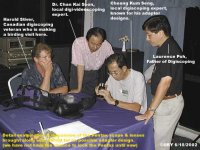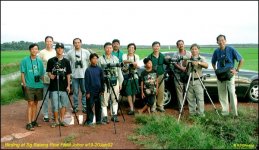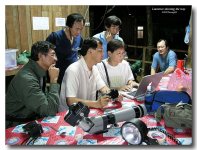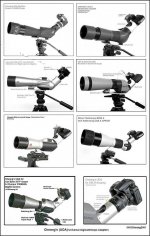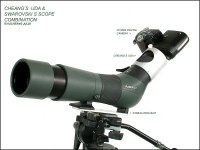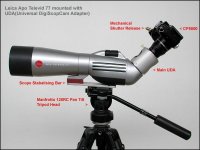-
Welcome to BirdForum, the internet's largest birding community with thousands of members from all over the world. The forums are dedicated to wild birds, birding, binoculars and equipment and all that goes with it.
Please register for an account to take part in the discussions in the forum, post your pictures in the gallery and more.
You are using an out of date browser. It may not display this or other websites correctly.
You should upgrade or use an alternative browser.
You should upgrade or use an alternative browser.
The Ultimate digiscoping rig (1 Viewer)
- Thread starter holzphoto
- Start date
More options
Who Replied?The SWARO APO digiscoping adaptor.....the Swaro 95mm scope etc... A 701 Manfrotto video head, .....
There, I started it... jim
Camera?
lewis20126
Well-known member
The SWARO APO digiscoping adaptor.....the Swaro 95mm scope etc... A 701 Manfrotto video head, .....
There, I started it... jim
I'm sure you are right with the scope, certainly the best one available.
cheers, alan
pan-tilt tripod head from Really Right Stuff - however, it is about $1700.oo USD! or the Acratech Pan-Tilt video head...both accept (only) Arca-Swiss Style plates - so are a bit more secure than Manfretto style plates. Both will handle up to a 50lb load...
Acratech Pan-Tilt (Video) head, arca-swiss style - about $600.oo: http://www.acratech.net/video-ballhead/
You might consider one 0f these for support of the scope: 8" lens support for arca swiss (Kirk Markins Wimberley Benro Acratech Hejnar):
http://www.ebay.com/itm/231076492596
Tripod - carbon fiber - the Benros are fine for about $300-$400. Three section (not four section)...but you can spend up to $1200.oo on a tripod (Really Right Stuff...carbon fiber) - the tripod should handle a load 4x the weight of the scope and digiscoping rig. In other words, if your scope, camera and adapter weigh 6 pounds - you should get a tripod rated to hold 25 pounds.
http://www.ebay.com/itm/Cayer-CT336...8&pid=100005&rk=4&rkt=6&sd=181472015700&rt=nc
Adapter - digidapter - $350 with accessories. Better than the Swarovski...I don't know if it is better than the Kowa adapter - but see his web site (Paul Sayegh is the designer in California):
http://www.digiscopeadapter.com/home.html
Scope - Kowa or Swarovski - it seems as though the 85mm ATX Swarovski is better for digiscoping than the 95mm ATX.
Camera - several options...Panasonic GH4 because of the 4K video; Sony A6000 with 28F2 lens (= 42mm in APS-C terms) - low price; high quality (APS-C sensor)...perhaps the Sony RX-1 with integrated 35mmF2 lens (I am testing it right now) - full frame sensor. Anyway, cameras are a personal choice...just get a lens that is the equivalent in SLR (35mm) terms - about 40mm otherwise you will get vignetting...Full frame sensor (in 35mm camera terms) cameras will vignette - but APS-C sensor cameras (Canon 7Dii; Canon 7D; Nikon D7100; Sony A6000) will not vignette.
Your choice is whether to use the camera plus lens plus adapter (digidapter for example) OR the camera without a lens shooting straight through the ocular of the scope. One then needs something like the Swaorvski APO TLO adapter. In this set-up the camera is further from the ocular...so more light is lost...so a slower shutter speed is needed and/or a higher ISO.
Buy as much as possible on the used market...
Acratech Pan-Tilt (Video) head, arca-swiss style - about $600.oo: http://www.acratech.net/video-ballhead/
You might consider one 0f these for support of the scope: 8" lens support for arca swiss (Kirk Markins Wimberley Benro Acratech Hejnar):
http://www.ebay.com/itm/231076492596
Tripod - carbon fiber - the Benros are fine for about $300-$400. Three section (not four section)...but you can spend up to $1200.oo on a tripod (Really Right Stuff...carbon fiber) - the tripod should handle a load 4x the weight of the scope and digiscoping rig. In other words, if your scope, camera and adapter weigh 6 pounds - you should get a tripod rated to hold 25 pounds.
http://www.ebay.com/itm/Cayer-CT336...8&pid=100005&rk=4&rkt=6&sd=181472015700&rt=nc
Adapter - digidapter - $350 with accessories. Better than the Swarovski...I don't know if it is better than the Kowa adapter - but see his web site (Paul Sayegh is the designer in California):
http://www.digiscopeadapter.com/home.html
Scope - Kowa or Swarovski - it seems as though the 85mm ATX Swarovski is better for digiscoping than the 95mm ATX.
Camera - several options...Panasonic GH4 because of the 4K video; Sony A6000 with 28F2 lens (= 42mm in APS-C terms) - low price; high quality (APS-C sensor)...perhaps the Sony RX-1 with integrated 35mmF2 lens (I am testing it right now) - full frame sensor. Anyway, cameras are a personal choice...just get a lens that is the equivalent in SLR (35mm) terms - about 40mm otherwise you will get vignetting...Full frame sensor (in 35mm camera terms) cameras will vignette - but APS-C sensor cameras (Canon 7Dii; Canon 7D; Nikon D7100; Sony A6000) will not vignette.
Your choice is whether to use the camera plus lens plus adapter (digidapter for example) OR the camera without a lens shooting straight through the ocular of the scope. One then needs something like the Swaorvski APO TLO adapter. In this set-up the camera is further from the ocular...so more light is lost...so a slower shutter speed is needed and/or a higher ISO.
Buy as much as possible on the used market...
Last edited:
For the best image quality, you can only start with the ATX95. I'm not yet convinced about the lens quality of the TLS, and the lack of AF is a disadvantage. I find the DCB unpractical. So I would combine the ATX with a Digidapter and the Panasonic GH4 with the 20mm/1.7 lens. Price: $6000
Personally I'd rather stick with my own ATS65 HD + DCA + Nikkor 18.5mm + Nikon V1, because it's light, fast and easy to use.
Personally I'd rather stick with my own ATS65 HD + DCA + Nikkor 18.5mm + Nikon V1, because it's light, fast and easy to use.
lewis20126
Well-known member
Scope - Kowa or Swarovski - it seems as though the 85mm ATX Swarovski is better for digiscoping than the 95mm ATX.
...
How can the 85mm be "better.." than the 95mm?
cheers, alan
with the Swarovski 85mm ATX you have a near magnification of 25x (it is 30x on the 95atx) - and 25x is often an easier focal length to work with...larger birds such as herons are easier to fit in the frame. Ask Neil from Hong Kong...he is a long-time digiscoper.
or from a previous thread..."Suppressor": "I have the 85mm and if your birding by bike its more than enough scope. It may not have quite the reach of the 95mm, but, it's lighter and has a wider field of view. Also it [85mm] is as bright at its lowest magnifaction ie exit pupil at x25=3.4. 95mm exit pupil at lowest magnifcation x30=3.16.And more compact too."
or from a previous thread..."Suppressor": "I have the 85mm and if your birding by bike its more than enough scope. It may not have quite the reach of the 95mm, but, it's lighter and has a wider field of view. Also it [85mm] is as bright at its lowest magnifaction ie exit pupil at x25=3.4. 95mm exit pupil at lowest magnifcation x30=3.16.And more compact too."
Last edited:
But what if you are going for small birds? is the 85 better than the 95?
also camera is important so let's hear complete set ups.
Wider zoom eyepiece at 25x is better in most situations. Geese/little egrets and bigger are hard to frame unless far away, with 30x. I rarely use 70x.
The Panasonic GH4 + 20/1.7 lens and Digidapter and Manfrotto 501/502 video head and Gitzo carbon fibre tripod that will handle up to 30 lbs and suit your height.
That should do it.
Neil
digiscoping equipment
Hi Neil - which gives you better image quality - a 4/3rds or even APS-C mirrorless camera with the digidapter (Paul Sayegh) OR an APS-C camera (such as the Canon 7Dii or Nikon 7100) attached directly to the scope via the Swarovski TLS APO adapter? In other words is having a lens at the end of the camera = better images...OR remove lens and use Swarovski adapter?
as one gets above 40x magnification, heat waves distort the air...that being said, if I was up in the north (Finland, Norway) or a cloudy place (UK) - the higher magnifications with the 95mm atx would be the way to go...gull, ducks and other waterbirds away from shore for example - in conditions where heat waves are absent.
The Panasonic GH-4 gets rave reviews for video - I think for stills other manufacturers (Sony) make a better sensor...the Sony A6000 is a great deal right now - about $450 used or a bit more new.
Digivideo comparison 85mm atx vs 95mm atx: https://www.youtube.com/watch?v=tdT5CCyP9Ho
Hi Neil - which gives you better image quality - a 4/3rds or even APS-C mirrorless camera with the digidapter (Paul Sayegh) OR an APS-C camera (such as the Canon 7Dii or Nikon 7100) attached directly to the scope via the Swarovski TLS APO adapter? In other words is having a lens at the end of the camera = better images...OR remove lens and use Swarovski adapter?
as one gets above 40x magnification, heat waves distort the air...that being said, if I was up in the north (Finland, Norway) or a cloudy place (UK) - the higher magnifications with the 95mm atx would be the way to go...gull, ducks and other waterbirds away from shore for example - in conditions where heat waves are absent.
The Panasonic GH-4 gets rave reviews for video - I think for stills other manufacturers (Sony) make a better sensor...the Sony A6000 is a great deal right now - about $450 used or a bit more new.
Digivideo comparison 85mm atx vs 95mm atx: https://www.youtube.com/watch?v=tdT5CCyP9Ho
When using the digiadapter w/ the panasonic 20mm it reduces your focal length:
http://lumixlounge.com/2015/01/digiscoping-long-lens-lumix/
so what would happen if you used the sigma 30mm 2.8 instead?
and Neil you are picking the GH4 as your camera? I looked at your old posts and you had some outstanding pics w/ the fuji models.
http://lumixlounge.com/2015/01/digiscoping-long-lens-lumix/
so what would happen if you used the sigma 30mm 2.8 instead?
and Neil you are picking the GH4 as your camera? I looked at your old posts and you had some outstanding pics w/ the fuji models.
Hi Neil - which gives you better image quality - a 4/3rds or even APS-C mirrorless camera with the digidapter (Paul Sayegh) OR an APS-C camera (such as the Canon 7Dii or Nikon 7100) attached directly to the scope via the Swarovski TLS APO adapter? In other words is having a lens at the end of the camera = better images...OR remove lens and use Swarovski adapter?
as one gets above 40x magnification, heat waves distort the air...that being said, if I was up in the north (Finland, Norway) or a cloudy place (UK) - the higher magnifications with the 95mm atx would be the way to go...gull, ducks and other waterbirds away from shore for example - in conditions where heat waves are absent.
The Panasonic GH-4 gets rave reviews for video - I think for stills other manufacturers (Sony) make a better sensor...the Sony A6000 is a great deal right now - about $450 used or a bit more new.
Digivideo comparison 85mm atx vs 95mm atx: https://www.youtube.com/watch?v=tdT5CCyP9Ho
I use the GH4 about 70% for video. If you don't want the best video then the Sony A6000 would be a better choice for stills and its video is good for HD. Another choice could be the Fuji X100S. With high magnifications you want an Electronic shutter to minimise vibration. Most cameras take excellent photos today compared to just a few years ago. On occasions I've shot with 5 different cameras and been happy with the results from all of them.
Neil
Neil - would you use the Sony A6000 (or any other mirrorless camera where you can change lenses) with a 24 F1.8 (or 28F2) lens - and the digidapter? OR would you use the same camera, without a lens and the Swarovski TLS APO adapter?
I think the latter option (no lens but using the TLS APO adapter) one loses 1-2 stops of light because the camera is further from the ocular...
However, if one goes the digiapter route (or any adapter that puts the camera/lens combo up against the ocular) and by using the fastest lens possible (eg. on the Panasonic Lumix, the 20mm F1.7) less light is lost - so faster shutter speeds (or lower ISO) can be used. However, if one uses a slower (say F4) lens on the camera next to the ocular (via the digidapter or whatever adapter) then all bets are off...no advantage.
And Neil - thank You! Through the years You have always been most helpful, patient and wise. A true Laurence Poh in spirit if you forgive my analogy for a moment.
I think the latter option (no lens but using the TLS APO adapter) one loses 1-2 stops of light because the camera is further from the ocular...
However, if one goes the digiapter route (or any adapter that puts the camera/lens combo up against the ocular) and by using the fastest lens possible (eg. on the Panasonic Lumix, the 20mm F1.7) less light is lost - so faster shutter speeds (or lower ISO) can be used. However, if one uses a slower (say F4) lens on the camera next to the ocular (via the digidapter or whatever adapter) then all bets are off...no advantage.
And Neil - thank You! Through the years You have always been most helpful, patient and wise. A true Laurence Poh in spirit if you forgive my analogy for a moment.
Last edited:
Neil - would you use the Sony A6000 (or any other mirrorless camera where you can change lenses) with a 24 F1.8 (or 28F2) lens - and the digidapter? OR would you use the same camera, without a lens and the Swarovski TLS APO adapter?
I think the latter option (no lens but using the TLS APO adapter) one loses 1-2 stops of light because the camera is further from the ocular...
However, if one goes the digiapter route (or any adapter that puts the camera/lens combo up against the ocular) and by using the fastest lens possible (eg. on the Panasonic Lumix, the 20mm F1.7) less light is lost - so faster shutter speeds (or lower ISO) can be used. However, if one uses a slower (say F4) lens on the camera next to the ocular (via the digidapter or whatever adapter) then all bets are off...no advantage.
And Neil - thank You! Through the years You have always been most helpful, patient and wise. A true Laurence Poh in spirit if you forgive my analogy for a moment.
Your very kind with your Lawrence analogy as he was very helpful to me when I got started.
Sony,Olympus,Fuji, Panasonic and Nikon all have very good cameras at the moment. There benefits of both approaches - adapter v TLSAPO. I don't use AF much anymore as its so easy to manually focus with the GH4 and Focus Peaking. So I would just go the TLS APO way. If it's windy/dusty though I like to keep a lens on the camera.
If you look through the various threads you'll find both approaches being used.
Neil
here are three photos from the early days in Malaysia - pre 2003. See attached images taken by Ooi Beng Yean and Cheang Kum Seng - still my friends.
So Neil - what are (IF ANY) the advantages of using a camera with a pancake lens and an adapter against the ocular of the scope VERSUS a camera without lens but using the Swarovski APO TLS?
In other words, are there certain situations where you would prefer one to the other - outside of the dust factor (which is where I gather you would prefer the camera/lens/adapter/ocular combo).
So Neil - what are (IF ANY) the advantages of using a camera with a pancake lens and an adapter against the ocular of the scope VERSUS a camera without lens but using the Swarovski APO TLS?
In other words, are there certain situations where you would prefer one to the other - outside of the dust factor (which is where I gather you would prefer the camera/lens/adapter/ocular combo).
Attachments
here are three photos from the early days in Malaysia - pre 2003. See attached images taken by Ooi Beng Yean and Cheang Kum Seng - still my friends.
So Neil - what are (IF ANY) the advantages of using a camera with a pancake lens and an adapter against the ocular of the scope VERSUS a camera without lens but using the Swarovski APO TLS?
In other words, are there certain situations where you would prefer one to the other - outside of the dust factor (which is where I gather you would prefer the camera/lens/adapter/ocular combo).
Nice photo memories.
NeilThere is practically only the magnification factor ( eg 20 mm v 30 mm is a 50% uplift) and Auto Focus or not. At distance I get more keepers with Manual Focus.
OK good to know! So let me see if I have your information correct:
there is no significant (noticeable) difference in image quality when one shoots with a camera + lens + adapter via the spotting scope versus camera + NO LENS + Swarovski (or any other brand) APO TLS via the spotting scope.
This means using the same camera in both scenarios (one that allows for interchangeable lenses such as a Sony A6000 or the Panasonic GH-4) - and the same spotting scope.
Why would one prefer using a 20mm lens (say the Lumix 20mm F1.7) versus a 30mm lens in the camera + lens + adapter + spotting scope scenario? Does an F1.7 lens provide more light or better quality or whatever versus a 30mm F2.8 lens?
Should one select a lens with as wide (F1.7) aperture as possible whenever possible?
What is the advantage of using a 20mm versus a 30mm lens...or vice versa?
Apologies for all the questions - I have indeed been reading through all the past threads here - but no one seems to have the extensive experience you do shooting with camera + lens + adapter as well as camera plus Swarovski APO TLS...this major division in equipment (comparison of advantages and disadvantages) - I don't remember reading anywhere.
Thank You,
rdc
there is no significant (noticeable) difference in image quality when one shoots with a camera + lens + adapter via the spotting scope versus camera + NO LENS + Swarovski (or any other brand) APO TLS via the spotting scope.
This means using the same camera in both scenarios (one that allows for interchangeable lenses such as a Sony A6000 or the Panasonic GH-4) - and the same spotting scope.
Why would one prefer using a 20mm lens (say the Lumix 20mm F1.7) versus a 30mm lens in the camera + lens + adapter + spotting scope scenario? Does an F1.7 lens provide more light or better quality or whatever versus a 30mm F2.8 lens?
Should one select a lens with as wide (F1.7) aperture as possible whenever possible?
What is the advantage of using a 20mm versus a 30mm lens...or vice versa?
Apologies for all the questions - I have indeed been reading through all the past threads here - but no one seems to have the extensive experience you do shooting with camera + lens + adapter as well as camera plus Swarovski APO TLS...this major division in equipment (comparison of advantages and disadvantages) - I don't remember reading anywhere.
Thank You,
rdc
Users who are viewing this thread
Total: 2 (members: 0, guests: 2)





